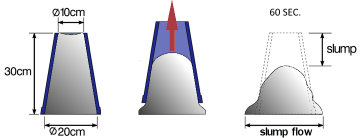Workability and Concrete Slump Ranges
Concrete Slump: What is it?
The slump test is basically a measure of the consistency of fresh concrete or its workability. Fresh concrete is placed in to a hollow steel cone known as a slump cone or Abrams cone and using the following procedure, the final slump can be determined.
- The slump cone mould should be thoroughly cleaned and coated with a thin film of oil.
- The slump cone mould is then placed on a smooth, flat, rigid and non-absorbent surface.
- The slump cone mould is then filled with four layers of the concrete mix, with each layer being tamped with a standard tamping rod.
- Once the mould has been filled the concrete mixture is levelled with the top of the cone.
- The slump cone is carefully lifted upwards, taking care not to disturb the concrete contained within.
- Once the concrete subsides the difference in height to the original height of the slump cone is measured as the slump.
More detailed specifics of the slump test are outlined in relevant standards dependent on the region.

Originally when used on the most basic of concrete mixtures the slump test would be a good indication of water content, workability and expected strength. With modern concrete however, there are many additives which can affect the slump, from add mixtures to different types of aggregates and even synthetic fibres for additional strength. Because of this, the concrete slump test is used to check the quality of concrete from different batches of the same mix design but not to compare different mix designs. As a typical guide small slump values indicate that the mixture will be hard to place and to consolidate, while high slump values attract with them segregation and possible excessive bleed water.
The following concrete slump heights have been provided as a guide only and assume the use of only the most basic of concrete mixtures.

Additional Resources
- ACI Committee 211. Standard Practice for Selecting Proportions for Normal, Heavyweight and Mass Concrete. USA. 2002. Print.
- Cement Concrete & Aggregates. Concrete Basics: A Guide to Concrete Practice. Australia. Print and Published in "CCAA website".
